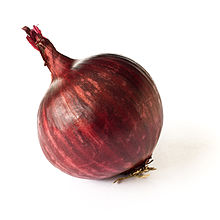Red onion
| Red onion | |
|---|---|
 A red onion | |
| Genus | Allium |
| Species | Allium cepa |

Red onions (also known as purple onions in some European countries) are cultivars of the onion (Allium cepa), and have purplish-red skin and white flesh tinged with red. They are most commonly used in the culinary arts, but the skin of the red onion has also been used as a dye.[1]
These onions tend to be medium to large in size and have a sharp flavor and eye-watering qualities.[2][3] They are often consumed raw (and can be added to salads for color and bite), grilled, or lightly cooked with other foods.[3] Red onions are available throughout the year and are high in flavonoids[4] and fiber (compared to white and yellow onions).[2] Cut red onion can be soaked in cool water for a period of time, and the water can be drained off, resulting in less "bite" and pungency.[5]
Red onion of Tropea[]

The red onion from Tropea, Italy, (Italian: "Cipolla Rossa di Tropea") is a particular variety of red onion which grows in a small area of Calabria in southern Italy named Capo Vaticano near the city of Tropea.[6] This onion has a stronger and sweeter aroma and the inner part is juicier and whiter than other red onions and it is possible to make a jam with it. In March 2008, the European Union registered the Protected Designation of Origin mark for the red onions produced in this particular area in Italy.[citation needed]
Red onion of Turda[]
The red onion from Turda (Cluj County,[7] Central Romania) (Romanian: "Ceapa de Turda",[8]) is a local variety of red onion with light sweeter taste and particular aroma. The area of cultivation encompass the lower Arieş valley and the middle Mureş valley.[citation needed]
Turda onion bulbs are traditionally intertwined into long strings (1–2 m) for marketing purposes and can be found at the traditional markets all over central Romania. "Turda Red Onion" is usually served fresh, as a salad or part of mixed salads and especially as a compulsory garnish for the traditional bean-and-smoked ham soups.[citation needed]
Wethersfield red onion[]
In the United States, one of the most prominent cultivars of red onion was grown in Wethersfield, Connecticut, and was a major source of onions for New England until the late 1800s.[9][10]
Other varieties[]
Known varieties also include 'Red Zeppelin'.[2]
References[]
- ^ Ernest Small Top 100 Food Plants, p. 367, at Google Books
- ^ Jump up to: a b c Bill Jones The Deerholme Vegetable Cookbook, p. 24, at Google Books
- ^ Jump up to: a b "Glossary". bbcgoodfood.com. Retrieved 28 June 2017.
- ^ Gennaro, Laura; Leonardi, Cherubino; Esposito, Fabrizio; Salucci, Monica; Maiani, Giuseppe; Quaglia, Giovanni; Fogliano, Vincenzo (2002). "Flavonoid and Carbohydrate Contents in Tropea Red Onions: Effects of Homelike Peeling and Storage". Journal of Agricultural and Food Chemistry. 50 (7): 1904–1910. doi:10.1021/jf011102r. PMID 11902931.
- ^ "Take the Bite Out of Raw Onions".
- ^ "Flavour of the Med - 6 August 2004". CatererSearch. 6 August 2004. Retrieved 19 September 2013.
- ^ OANCEA, SIMONA; DRĂGHICI, OLGA (May 2013). "pH and Thermal Stability of Anthocyanin-based Optimised Extracts of Romanian Red Onion Cultivars". Czech Journal of Food Sciences. 31 (3): 283–291. doi:10.17221/302/2012-CJFS.
- ^ "Onion Turda on the Harvest Day in Cluj" (in Romanian). turdanews.net. Retrieved 30 June 2017.
- ^ "A Great Trade Vanished. How Connecticut's Onion Monopoly Was Lost", The New York Times, 2 June 1889
- ^ "Wethersfield, CT, and Onions", Yankee Magazine, August 1993
External links[]
| Wikimedia Commons has media related to Red onions. |
- Onions
- Onion cultivars
